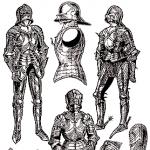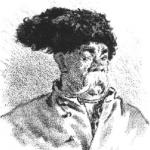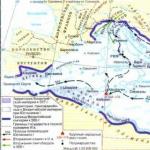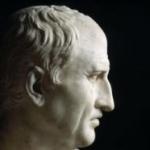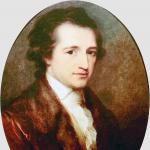In the article by the leading scientific consultant of the Institute of Oriental Studies of the Russian Academy of Sciences, Doctor of Historical Sciences Irina Mikhailovna Smilyanskaya, “The Arab World in the Views of Russian Pilgrims of the 12th - First Half of the 19th Centuries,” a detailed analysis of the travel notes of the first pilgrims to the Holy Land was carried out.
The Arab world in the views of Russian pilgrims of the 12th - first half of the 19th centuries.
Until the second half of the 18th century, the Arab West - the Maghreb - was almost unknown to the Russians, unlike the inhabitants of southern Europe, who did not have direct contacts with the Arab world. However, since the adoption of Christianity, ties with the Arab East - Mashreq, or more precisely with the Holy Land - Palestine, Egypt and Sinai have become noticeable. The earliest Russian written evidence about this region - “The Life and Walking of Danil, the Russian Land Abbot” - dates back to the very beginning of the 12th century, that is, created six centuries after the establishment of Arab rule in it, temporarily interrupted by the conquests of the Crusaders. Meanwhile, in Western Europe, the first records of pilgrims about the Holy Land, itineraria (“travelers”), appeared at the beginning of the 4th century, long before the conquest of this land by the Arabs. By the time of the pilgrimage of Abbot Daniel, they, like the Byzantine proskinitary (“prayer walks”), had developed into a developed written tradition. Daniel was certainly familiar with some of these works and, having learned the experience of these predecessors, wrote an original work that laid the foundation for the genre of Russian walks.
.jpg)
The desire of Christian pilgrims to visit Palestine was explained by the dominant Christian cosmology in the Middle Ages, which determined the picture of the world, at least until the Renaissance. According to this cosmology, in Jerusalem at Golgotha there was the center of the universe (the place “in the middle of the earth, where Christ was crucified”), nearby was the Navel of the earth, relative to which the “limits” and “edge” of the Universe were determined. According to folklore tradition, here the earth met the sky. Within Jerusalem, Jacob in his prophetic dream saw a ladder connecting earth to heaven. It was believed that in the vicinity of Jerusalem the Last Judgment was about to take place, after which, according to the Revelation of John the Theologian, Heavenly Jerusalem would descend from heaven and the kingdom of God would come.
The extensive literature about the Holy Land, which arose as a result of pilgrimages to Palestine, would seem to make it easier to reconstruct the image of the Arab world that developed back in Ancient Rus'. However, religious consciousness determined the specific features of this literature: in it, the biblical image largely obscured the realities. In this way, the notes of pilgrims (walkings) differ from travel, which should be taken into account when analyzing the information contained in them.
The publication and study of pilgrimage literature in Russia has a strong tradition. However, this work was carried out primarily for literary and historical-theological purposes. Only in the 1950s, attempts were made to specifically study pilgrimage literature in an orientalist aspect, which ultimately culminated in 2010 with the publication of S. A. Kirillina’s fundamental work “Enchanted Wanderers”: the Arab-Ottoman world through the eyes of Russian pilgrims of the 16th-18th centuries.” , the source study aspect of which has been developed almost exhaustively and which opens the way to further, now private, research.
Differentiation of different directions in the study of pilgrimage literature has not only its advantages, but also some disadvantages. In particular, orientalists have not sufficiently taken into account the impact of biblical ideas on pilgrims' perceptions of the real world; they leave out of the scope of the study the Arab folk culture that formed and developed around the holy places. In addition, researchers often ignore the evolution of the worldview of the pilgrims themselves.
We must also keep in mind that the pilgrims' ideas were not the only source of information about the Arab world. His holistic image was also formed under the influence of Byzantine books, Russian folklore, oral stories of returning eyewitnesses, and, from the second half of the 17th century, Western European travel to the Middle East. Moreover, each era generated its own image. Its reconstruction (if possible) requires an indispensable analysis of the ways in which these ideas are transmitted from generation to generation. However, only the influence of Daniel’s “Walk” on pilgrimage literature and the reflection in the work of John Lukyanov of previous pilgrimage notes have been relatively seriously studied. Summing up information from pilgrims about Arab countries and their inhabitants over a long period allows us to create a corpus of sources, but not to fully reproduce the pilgrimage picture of the Arab world: such summation is an extrapolation of pilgrimage ideas by our consciousness, enriched with modern scientific knowledge.
The author of this article, relying on the multifaceted work of S. A. Kirillina, aims to clarify the factors that influenced the formation of the pilgrims’ ideas, to consider the characteristics and evolution of these ideas.
As St. Petersburg literary critic M. V. Rozhdestvenskaya notes, “the biblical text and Holy Scripture determined the choice of artistic techniques, stylistics, system of symbols and figurative analogies of ancient Russian literary monuments.” Naturally, the Bible had a special influence on the pilgrims’ notes and their vision of Palestine. The plots of the canonical and apocryphal texts of the Old and New Testaments determined the places of worship, their religious meaning, the canon of the very description of the Holy Land, which pilgrims adhered to until the end of the 18th century.
The analysis of this canon goes beyond the scope of the article, but the routes of movement of pilgrims are relevant to the question of the formation of early ideas about the landscape-geographical space of the Holy Land.
In their reports about the movement to places of worship, pilgrims followed the tradition of “describing the path” that arose in antiquity, that is, itineraries. Such guidebooks contained, first of all, a list of the settlements they had seen, brief information about them and information about the distance between them, which Russian pilgrims measured using different measures. They measured large, unfamiliar transitions by days of travel (see, for example, “Walking” by guest Vasily); roads, measured and described many times, in versts (rarely in stages: 15 stages amounted, “in our opinion,” to 3 versts); small spaces - with the flight of an arrow fired from a bow or a thrown stone. (Daniel even specified: “a small stone thrown by a husband.”) The interior was measured in cubits, fathoms, and steps. (According to E.I. Maleto’s calculations, the errors in all these measurements did not exceed 3%). Attention to these dimensions, apparently, was partly due to the idea of the mystical-symbolic meaning of the number, which the pilgrims sought to penetrate.

Methods of orientation in space throughout the XII-XVIII centuries remained archaic: the pilgrim marked the observed objects depending on his own location (“left”, “right”, “behind”, etc.), or proceeded from more abstract concepts, indicating directions to cardinal directions from a certain center, which in Palestine was usually Jerusalem. Traditions in the description of the path and methods of orientation in space allowed Abbot Daniel, who walked around almost all the memorable places, to outline with great completeness the landscape and geographical borders of Palestine. Thus, he created for the Russian reader the first kind of virtual domestic map of Palestine. In the 14th and 15th centuries, the geographical views of Russian pilgrims expanded noticeably: Archimandrite Agrephenius in 1370 reached Damascus, which was located under Daniel outside the Kingdom of Jerusalem; the latter did not dare to go there. A century later, in 1461-1462, Barsanuphius reported on the route to Egypt and Sinai, and guest Vasily in 1465-1466 left a detailed description of his movement through the territory of Asia Minor and Syria: through Gaza and the desert of the Isthmus of Suez to Cairo, and so on. .
It is characteristic that some of the errors in the descriptions of lands made by pilgrims arose as a result of the mythological identification of territories located outside the Holy Land with those discussed in the Bible. Thus, having reported about certain six rivers flowing east from “Mount Lebanon,” Daniel argued that between these rivers lies Mesopotamia, “which is also the Middle River; and between those rivers is Harran, but Abraham came from nowhere.” Guest Basil, who arrived in Palestine through Syria, mixed the rivers Orontes and Barada with the Euphrates, this biblical river, supposedly, like the Nile, flowing from paradise.
The pilgrims' impressions of the Holy Land partly depended on the conditions of stay and movement across its territory, in other words, on the organization of the pilgrimage itself. Christian pilgrimage to Palestine originated as early Christians visiting iconic places in memory of the events that took place there. “In other words, Jerusalem and its surroundings were considered as one large temple with many altars, at which services were performed in turn, and each such place had its own special liturgical significance.” But by the time Daniel was in Palestine, visits to holy places often did not coincide with the church calendar, and only the Easter service in the Church of the Holy Sepulcher with the miracle of the descent of the Holy Fire was what all pilgrims sought to see. However, there were exceptions here too: guest Vasily, having passed Bethlehem, celebrated Christmas in Egypt, and left Jerusalem on his way back, apparently without waiting for Easter. Daniel noted only once that of his three trips to the Jordan, one was at Baptism. (He was, naturally, in Jerusalem for Easter). Apparently, there were no more coincidences with the church calendar in his walks, or he did not note this, since he did not attach much importance.
It seems that the discrepancy between the time of worship of a memorable place and the church calendar had already become so commonplace by the 12th century that in itself it testified to the transformation of pilgrimage into an independent institution, with its own services and culture. In Jerusalem, Abbot Daniel lived in one place (as already noted, the metoche - the courtyard of the monastery of St. Sava), and he himself was looking for guides for himself (“And God grant me to find in the Lavra a husband who is holy and old in days, and a book of greatness.” Piety, age and book knowledge were for Daniel the guarantee of the veracity of the information of such a guide). Archimandrite Agrephenius complained that due to ignorance of the language, having passed Mount Tabor and the city of Nazareth on the way from Damascus to Jerusalem, he no longer knew where he was (“I don’t know what he’s eating”) until he saw the holy city (which means he didn’t have guide and translator). For safety, Daniel and his companions moved around the country together with armed detachments of crusaders. This suggests that the organized pilgrimage caravans that fans wrote about in the 16th-18th centuries did not yet exist. Then, included in a huge pilgrim stream, they moved according to the established rule from monastery to monastery, both within Jerusalem and throughout the country; For this purpose, they were assigned guides who, when traveling long distances, forced them to use riding animals. Agrephenius, in 1370, was still wandering with random companions.
Hegumen Daniel accompanied the description of sacred places with a retelling of biblical texts, very correctly supplementing them with brief explanations. Perhaps his comments reflected the mythology of holy places that existed among the highly educated inhabitants of local monasteries of that time, like the “bookish man” - the abbot’s guide. Daniel took up arms against those who “lie a lot and whore”, falsely, and not “truly” report about these shrines. Apparently, the abbot had in mind guides who abused the retellings of popular beliefs that multiplied around holy places. Daniel, for example, has no information about the miraculous impressions left by Christ’s feet on stone, “as if on wax.” However, Agrephenius already wrote that the footprint of Christ “is inscribed in the stones, and then they worship the Holy feet (footprint) of Christ.” Later pilgrims have descriptions of new stones with footprints of Christ and even the hooves of his donkey, who once stopped in front of the Holy of Holies temple. At Sinai, pilgrims saw a stone in which the bowed figure of Moses was imprinted at the moment when the Lord “passed by” him. On the stone of the Jerusalem gates, fans were shown the footprint of an angel leaning on the stone to open the gate with his shoulder and let people into the city to accompany Christ on his way of the cross to Calvary. At the beginning of the 18th century, Christians and Muslims worshiped a depression in the stone that framed the window of the Tower of David, supposedly left by the elbow of the dozing prophet when he wrote the Psalter, and so on and so forth. A. N. Veselovsky considered it possible to date the appearance of such folk beliefs based on early mentions of them. However, we can confidently conclude, for example, about the relatively late emergence in the Arab, perhaps even Muslim, environment of the legend about the angel who handed the keys to Jerusalem to the stylite for their transfer to the Muslim conquerors.
Mentions of stylites have also undergone evolution. Daniel did not yet doubt the asceticism of the stylite he saw. And John Lukyanov was already aware that such a “recluse”, located on a high stone pillar near the Savvina Monastery, was only a “pilgrim for an hour”, who “was blown away as if by the wind” after the pilgrims moved away from the monastery.

The interest of pilgrims in the realities of the Holy Land arose not only under the influence of biblical stories or useful information about the organization of pilgrimages. This interest was determined by other factors. Apparently, the state authorities began quite early to attach importance to the information provided by pilgrims and to assign religious and political assignments to pilgrims. The pilgrims mentioned such assignments in their notes. However, researchers, based on the walking routes and the contents of the notes themselves, make assumptions about the fulfillment of government orders by the pilgrims, who were silent about this. Thus, the communication of Abbot Daniel with the King of Jerusalem Baudouin I (“call me to you with love...”) gave reason to write that his “trip was organized by Russian princes in order to clarify the military and political situation that had developed in the Middle East as a result of the Crusades.” campaigns that were not supported in Rus'." Indeed, Daniel's Walk contains information about the political situation in Palestine. They presented the Kingdom of Jerusalem in a hostile Muslim environment. By this he explains the need for the crusaders to carry out military campaigns within the Muslim possessions. However, even within the kingdom, the knights did not feel safe, being forced to move around the country as part of armed detachments and constantly be ready to repel the resistance of the conquered people. However, part of the Muslim population collaborated with the crusaders. Thus, Daniel and his companions were warmly received by the mixed Muslim-Christian population of a large village, and to the amazement of the abbot, the Muslim (“Sratsinsky”) elder “led him with weapons to Bethlehem” in order to protect him from Muslim attacks.
The route of the merchant Vasily's movement to the Holy Land gave rise to the assumption that the purpose of his journey was to clarify the political situation that had worsened in the area where the interests of the Ottoman power, the Ak-Koyunlu state and the Mamluk Sultanate intersected (by the way, he hurried on the return trip without taking part in the Easter worship service). Vasily did not leave Istanbul, like most pilgrims, but from Bursa, and at first his path lay towards the possessions of the white-sheep Turkmens, and only then, through the Syrian lands of the Egyptian-Syrian Mamluk Sultanate, bypassing the holy places of Palestine, he headed to Cairo. At the same time, Vasily recorded the borders of these states, and along the way provided information that allows us in our time to judge the process of political and ethnic demarcation between the Ottoman sedentary Turks and the nomadic white-sheep Turkmens.
Profession and social status also influenced the interests of pilgrims: merchants noted the state of trade, townspeople paid attention to the features of urban planning and the defense capability of settlements. All pilgrims were equally interested in fortifications - probably from the point of view of the experience of military construction, so vital in the conditions of military-political instability of medieval society, the eternal threat of internal strife and external attacks. Even Abbot Daniel, extremely stingy with worldly subjects, described the fortifications of Jerusalem. He noted the fact that a strategic reserve of grain was stored in the Tower of David (“there is countless life in it”) and concluded that the “pillar” of David “is a lot of strongholds that can be taken, and that is, the head of that whole city.”
The main factor that influenced the pilgrims’ perception of the Arab world was the change in the process of historical evolution of large cultural styles, which can be considered as milestones that recorded changes in the worldview of a person of European culture. The idea of the transformation of pilgrimage literature from this angle is facilitated by the theoretical developments of philologists D. S. Likhachev, A. M. Panchenko, L. V. Levshun, L. A. Olshevskaya and others, but when comparing the evolution of pilgrimages with the development of other genres of Russian literature One should take into account the archaic nature of pilgrimage notes and the lag in their evolution from other literary genres.
The beginning of the 12th - the first decades of the 15th century constituted an era in pilgrimage literature that D. S. Likhachev called “historical monumentalism” (it corresponded to the Romanesque style in Western Europe). This era was distinguished by the dominance of the theocentric picture of the world. Its most characteristic representative was Abbot Daniel. In terms of their worldview, Archimandrite Agrephenius and Hierodeacon Zosima were close to him, although their worldview already had features that brought them closer to the pilgrims of the late 15th century.
The second half of the 15th - first half of the 17th centuries was the era of the Proto-Renaissance, or the emergence of an anthropocentric worldview, the features of which can be found in the notes of Hieromonk Barsanuphius, the “guest” Vasily, the merchants Vasily Poznyakov and Vasily Gagara.
The second half of the 17th - first half of the 18th century in literary criticism is defined as the Baroque era. Its most notable figures among the pilgrims were Arseny Sukhanov, Ioann Lukyanov and Ippolit Vishensky.
The middle - second half of the 18th century, the era of classicism, was marked by the great influence of Enlightenment ideas on literature. This period is represented by the notes of monk Vasily Grigorovich-Barsky, Archimandrite Leonty Zelensky, priest Ignatius Denshin and hieromonk Meletius. (L.V. Levshun attributes the last two periods in the development of literature to the era of the “egocentric worldview” due to a clearly expressed personal principle).
Finally, the pilgrimage notes created in the first half of the 19th century (descriptions of travel to the Holy Land by D.V. Dashkov, A.N. Muravyov, A.S. Norov and P.A. Vyazemsky) left their mark on the aesthetics of romanticism.
A pilgrim in the general sense is a person going to a holy place for him. One can call this a person returning, for example, to his hometown, to his place of birth, but in the basic sense of the word, pilgrimage is a visit to holy places associated with the religion that the pilgrim professes. The word is derived from the Latin “palma”, reminiscent of the palm branches with which people greeted the Lord Christ at His Entry into Jerusalem shortly before death on the cross.
We will tell you where the routes of the most famous Christian pilgrimages are and what traditions they are associated with.
Israel pilgrimage
The main pilgrimage in all ages is the pilgrimage to the Holy Land, to Jerusalem, to the places of Christ’s earthly life. Most pilgrimages take place on Orthodox Easter. On Holy Saturday, the miracle of the descent of the Holy Fire takes place here.
This is truly a miracle that people expect every year with faith and hope. Its meaning is the self-ignition of the lamp on the Holy Sepulcher in the presence of the Patriarch of Constantinople. They prepare for the Holy Saturday service in advance, but no one knows at what hour the Holy Fire will descend. According to legend, one year he will not appear, and this will mean the onset of the end times, the End of the World.
Every year, on Saturday morning, the Ecumenical Patriarch with a retinue of clerics enters the Church of the Resurrection of Christ and strips himself to a white cassock in its center, at the Chapel of the Holy Sepulcher (Edicule), which stands above the very place where Christ was resurrected, above the Stone of His Sepulchre. All light sources in the temple are extinguished - from lamps to chandeliers. The Patriarch, according to the tradition that emerged after the Turkish rule in Jerusalem, is searched for the presence of anything that would contribute to the ignition of the Fire. The sacristan brings into the Edicule cave a lamp, which is placed in the middle of the Holy Sepulcher, and the same torch of 33 Jerusalem candles. As soon as the Orthodox Patriarch enters there, accompanied by the Primate of the Armenian Church, the cave with them is sealed with wax. Pilgrims fill the entire temple - the words of prayers are heard here, the confession of sins takes place in anticipation of the descent of the Fire. Typically this wait lasts from several minutes to several hours. As soon as flashes of lightning appear above Edicule, signifying the Convergence, a bell rings above the temple. Many millions of people over the centuries have witnessed this miracle, because even today scientists cannot explain with anything other than God’s power the flashes of lightning in the temple on Holy Saturday.
The patriarchs pass Jerusalem candles into the chapel window, and pilgrims and priests in the temple begin to light their torches from them. Again, from a few minutes to an hour the Holy Fire does not burn and pilgrims scoop it up with their hands and wash their faces. Fire does not ignite hair, eyebrows, or beards. All of Jerusalem is ablaze with thousands of candle torches. By air, representatives of Local Churches transport the Holy Fire in special lamps to all countries where there are Orthodox believers.

Pilgrimage to Bari to the relics of St. Nicholas the Wonderworker
Saint Nicholas the Wonderworker is world famous and revered by all Christians. He lived in the 4th century, but even today he remains dear and beloved to many people, because he continues to hear our prayers, help those who turn to him, save them from death, poverty, melancholy and many troubles.
Immediately after he departed to the Lord, his body began to exude myrrh - a miraculous liquid that comes only from miraculous icons and holy relics. Soon he was canonized. The remains and bodies of saints are called holy relics.
The relics of St. Nicholas the Pleasant were in his hometown, in a church in his honor, and in 1087, Italian merchants from the city of Bari deceitfully took the holy relics and took them to Italy. Here they are in a white marble closed sarcophagus in the basilica in honor of St. Nicholas. Many pilgrims from all over the world come here every day.
The relics constantly exude myrrh, stream myrrh. Miro is a wonderful fragrant liquid, the exact composition of which scientists still cannot name. The myrrh exudes miraculous icons and the relics of some saints especially blessed by God. This substance is a fragrant oil, and it contains the essential oils of unknown plants, as if unearthly.

Pilgrimage to the relics of Spyridon Trimifuntsky in Corfu
Saint Spyridon is the second miracle worker after Nicholas the Wonderworker, Archbishop of Myra. After long years of oblivion during the godless years of the twentieth century, Russians again pray to St. Spyridon, and over the past decades, evidence of his miracles has multiplied.
Saint Spyridon is called a miracle worker, like Saint Nicholas. He is considered one of the great patrons of Greece; his relics rest on the island of Corfu. In all centuries, people turned to the saint and found help; in Russia of the twentieth century his name was forgotten, but today the veneration of the saint is being revived again.
The relics of Spyridon of Trimifuntsky are located on the island of Corfu and exude great miracles. They are a sign that the saint walks among people and helps them: it has been testified over the centuries that Spyridon’s shoes, worn on his holy relics, are changed annually and their soles are always worn out! This amazing fact strengthens people’s faith that the saint rises invisibly from the grave and himself walks around the world, appearing to people and strengthening them.
Other amazing facts about the saint's relics: the saint's body has a constant temperature of a living person, just above 36. His hair and nails continue to grow slightly. And over the centuries, it happened many times that the key could not open the lock on the shrine (coffin) with the relics. Then everyone becomes a witness: the saint walks around the world and helps the suffering.

Pilgrimage to Saint James - Saint Jacques in Spain
The relics of Saint James, brother of John the Theologian, are especially revered in Spain. He preached in those places, following the wine route from Jerusalem (which is why he is revered as the patron saint of travelers and pilgrims). According to legend, after he was killed by Herod, his body was carried in a boat to the bank of the Ulya River. Now here is the city named after him, Santiago de Compostela. In 813, one of the Spanish monks received a sign of God: a star, with its light showing the burial place of the relics of Jacob. The name of the city built on the site of their discovery is translated from Spanish as “Place of St. James, designated by a star.”
From the 10th century, a pilgrimage began here, which by the 11th century acquired the significance of the second pilgrimage in status after visiting Jerusalem. Ancient pilgrimage traditions are still observed today: the pilgrim must reach the city on foot, walking for one hundred kilometers or pedaling a bicycle for two hundred kilometers.
God bless you!
Pilgrimage in Rus' can be divided into two independent branches, defined by the very history of the Christian religion: the actual pilgrimage to the Holy Land and the pilgrimage to holy places on the territory of Rus', as the center of world Orthodoxy. Pilgrimage to the Holy Land began in Rus' in the early times of Christianity. Historians date the first documented pilgrims to the 11th century. So in 1062, Abbot Varlaam of Dmitriev visited Palestine. Clergy who were literate and able to convey their impressions to the church were appointed to the pilgrimage. Essentially the first Russian pilgrim who left fairly detailed notes about his wanderings on St. Land, was abbot Daniel. He left notes known as "Walking" (1106-1107), which were copied in large quantities, preserved and published many times in the 19th century, as well as earlier. Another famous pilgrim is Archbishop Anthony of Novgorod, who made a pilgrimage to Russian holy places at the end of the 12th century. He compiled unique descriptions of the St. Sophia Cathedral and its treasures, which were later lost as a result of wars and destruction. In 1167, the Venerable Euphrosyne of Polotsk (daughter of Prince Svyatoslav-George Vseslavovich of Polotsk) made a pilgrimage to Jerusalem. In 1350, a pilgrimage to St. The land was visited by the Novgorod monk Stefan, who left detailed descriptions of the Constantinople shrines. It is known that he also visited Jerusalem, but written accounts are lost. In 1370, a pilgrimage to Jerusalem was made by Archimandrite Agrefenya, who left unique descriptions of the shrines of Jerusalem (published in 1896). further in this period of the late XIV century. travels to Jerusalem, Constantinople and Athos by Deacon Ignatius Smolyanin and Novgorod Archbishop Vasily are known. The “walk of the holy monk Barsanuphius to the holy city of Jerusalem” is known, discovered in a manuscript of the first quarter of the 17th century. in 1893 N. S. Tikhonravov. It contains a description of two pilgrimage passages: in 1456. - to Jerusalem from Kyiv through Belgorod, Constantinople, Cyprus, Tripoli, Beirut and Damascus, and in 1461-1462. - through Belgorod, Damietta, Egypt and Sinai. Barsanuphius was the first of the Russian pilgrims to describe St. in sufficient detail and accurately. Mount Sinai.
From the middle of the 15th century. A new stage is beginning in the history of Russian pilgrimage. After the capture of Constantinople by the Turks, many Christian shrines of the East were finally lost. The pilgrimage became difficult and unsafe. An institution and tradition of pilgrimage to local shrines is being formed. Russian pilgrimage to St. Land in the period XV-XVI centuries. insignificant in number, there are few descriptions of travel. Famous ones include the circulation in 1558-1561. merchant Vasily Poznyakov, who gave a unique description of the Jerusalem and Sinai shrines. The famous “Proskinitarium” of Arseny Sukhanov, hieromonk, builder of the Trinity-Sergius Epiphany Monastery and cellarer of the Trinity-Sergius Lavra, also owes its origin to the official commission. In 1649 he visited Mount Athos, and in February 1651. he visited Constantinople, Chios, Rhodes and other islands of the Greek archipelago, penetrated Egypt and Jerusalem, and returned through Asia Minor and the Caucasus in June 1653. to Moscow. Thanks to the rich “alms” that were provided to him, Arseny managed to take 700 unique manuscripts from Athos and other places, which are considered an adornment of the Moscow Synodal Library.
Later in the 18th century. The pilgrimage of the traveler Vasily of Kyiv, who devoted himself to the study of the Orthodox East, is known. In Rus' there is a firm conviction that the Orthodox faith is preserved in its purity only here, that Holy Rus' remains the only Orthodox kingdom. Many church leaders of that period called for pilgrimages to the borders of Rus', to draw piety and educate with national origins. The times of mass pilgrimage to Russian holy places are coming. In the XVI-XVII centuries. Rus' was recognized as the center of the Orthodox world even outside the state. Representatives of local Orthodox churches visited the Moscow state for pilgrimage purposes. Valaam and Solovki became centers of pilgrimage.
Sometimes people go on a pilgrimage “to repentance” in order to be cleansed of sin through the feat of pilgrimage. Often Russian people undertook votive pilgrimages - according to a vow made to God in illness or everyday sorrow. Even more often, sick people came to the shrines, hoping for healing from physical or mental illness through touching the shrine.
A pilgrimage by vocation takes place when the Lord Himself or some saint in a dream or vision called a person to go somewhere. Russian pilgrims most often went to Kyiv, wanting to visit the “Mother of Russian Cities”, with her shrines, primarily the Kiev Pechersk Lavra, its Near and Far Caves with numerous relics of holy ascetics. The most important Russian center of pilgrimage in the 15th century. the Trinity-Sergeev Lavra appeared, where even Russian tsars, according to tradition, went to bow to the abbot of the Russian land, St. Sergius. In the 19th and early 20th centuries. Sarov and Optina Pustyn also became especially visited centers of pilgrimage. The last of them stands somewhat apart. Pilgrimages were made to Optina solely for the purpose of communicating with the elders.
The pilgrimage usually took place in the warm season. This is explained by the fact that real pilgrims were supposed to go to holy places on foot in order to work for the glory of God. Orthodox pilgrims did not have a special costume (unlike Western pilgrims), but their mandatory equipment was a staff, a bag of crackers and a vessel for water.
XX century - a time of mass pilgrimages to the holy places of Russia. After 1910 The Moscow priest of the Church of the Resurrection in Kadashi, Father Nikolai (Smirnov), began parish pilgrimages in the outskirts of Moscow and in distant monasteries. Others followed his example. It is known, for example, that even after the revolution in the 1920s, the parish of the Church of St. Mitrophanius of Voronezh, under the leadership of its rector, Father Vladimir Medvedyuk, made near and far pilgrimages (including to Sarov). Today this pious tradition has been revived. Almost every church has its own experience in conducting pilgrimage trips or trips to Russian shrines: these are the Trinity Church in Ostankino, the Temple of the Apostle Philip, the Church of the Ascension (Malaya) and other parishes. In St. Petersburg, the Valaam Monastery has its own pilgrimage service, which organizes pilgrimage trips to the islands of Valaam and Konevets. In June 1997 The head of the Orthodox Church of Russia, Patriarch Alexy II, made a pilgrimage to Jerusalem.
Pilgrimage(from lat. Palma- “palm tree”):
- Journey to the Holy Land and other geographical areas of sacred significance for the Christian faith for the purpose of worship and prayer;
Those going to the Holy Land were called pilgrims - from the Western palmari, palmati, palmageri (they were returning from the Holy Land with palm branches); pilgrims - from the western region grinus ; kalikami - from the Greek kaliga (type of shoe).
Initially, the tradition of pilgrimage grew out of the desire of Christians to visit the Holy Sepulcher - the place where He Himself lay in the flesh and then resurrected. Saint Cyril of Jerusalem and Blessed. Theodoret of Cyrus testifies that in the times of the apostles a pilgrimage to Jerusalem began to venerate the holy relics. They also talk about raising funds for pilgrims during the agape (meetings) of the first Christians. And pilgrims began to visit Jerusalem especially often IV V. - after finding the Cross of the Lord, St. Queen Helena.
Blessed Jerome (340-420), creates an entire community of Jerusalem pilgrims, calling them seekers of the path of God. This community consists of doubters and wavers who study the holy places under his guidance. Blessed Jerome, a famous writer and ascetic of the Christian Church, the creator of the Vulgate - the Latin translation of the Bible, testifies to the pilgrims of his time: “... They, according to the word of the Savior: “Where there is a corpse, there the eagles will gather (Matt. XXIV . 28), flock to these places and present to us a spectacle of all kinds of virtues."
In Russia, pilgrimage appeared immediately with the adoption of Christianity, or rather, even earlier. Thus, N.M. Karamzin and Metropolitan Macarius (Bulgakov) believe that one of the first Russian pilgrims was the holy princess Olga, since her journey to Constantinople to receive baptism at the old age of 67 cannot be explained by anything else as a desire to personally see “the abundance of holy relics, miraculous icons and, in general, every Christian shrine there.”
During the reign of the grandson of Prince. Olga Grand Duke Vladimir - the Baptist of Rus', went to Constantinople and the holy Mount Athos from the city of Lyubech, St. Anthony, future founder of the Kiev Pechersk Lavra. On Athos, he took monastic vows and, having become experienced in spiritual life, returned to Kyiv, where he soon founded a monastery, which later became one of the centers of pilgrimage.
Varlaam, the first to be appointed by St., also traveled to Palestine. Anthony, abbot of the Kiev Pechersk, then abbot of the Dmitrov Monastery. Having visited the holy places of Palestine and returning to his monastery, he went to Constantinople for the second time and, returning from there with the many icons, vestments and church utensils he acquired,
K XII V. refers to the first known pilgrimage work - “The Wanderer” or “Pilgrim” by Abbot Daniel.” It was known to the Russian reader, including the common people, because it was in numerous lists right up to XIX century
From the story of Abbot Daniel it follows that he did not go to Palestine alone, but “his squad” was with him. And in Jerusalem itself, on the Easter holiday, at the same time there were “Novgorodians and Kiyans and many other people.” He speaks very modestly about his journey, which he made, “compelled by my thoughts and my impatience to see the Holy City of Jerusalem and the Promised Land” and wrote everything that he saw ... “for the sake of the faithful people,” so that when they heard about the Holy places, they would grieve and think about them and accepted from God an equal reward with those who reached them.” Hegumen Daniel believes that those who go to the Holy Land should not think of themselves as “having done something good,” so as not to lose “the reward of their labor.”
XV The century was a turning point in the history of the development of Russian pilgrimage. The capture of Constantinople by the Turks in 1453 played an important role in changing the situation. Its shrines became inaccessible to Christians, visits to the holy places of Palestine were also controlled by the Turks, and on the way there, pilgrims were increasingly robbed by Arabs and European pirates. From that time on, the consciousness that arose among the Russians that within their land the purest tradition of Orthodoxy was preserved, that there were many shrines worthy of worship, and that their fatherland had become the only powerful Orthodox kingdom, caused internal Russian pilgrimage to develop widely.
Russian pilgrimage from the second half of the 15th century V. before the revolution is closely connected with the history of the Russian Church, and the latter - with the history of the development of the Russian state itself - the development of new lands, the rise and fall of individual cities, the emergence, prosperity and impoverishment of monastic monasteries in different Russian lands, changes in the population and class composition in different parts country, various government policies regarding the Church and monasteries, in particular, the appearance and disappearance of new shrines, the glorification of Russian saints and many, many other events in the history of our country, so dynamic and rich in changes during this period.
It is impossible even within the framework of a whole seminar to contain all the richness of the tradition of Russian pilgrimage. The veneration of relics, icons and other church relics was organically combined with spiritual nourishment among the elders, prayer books of the Russian Church and simple monks of local monasteries, most famous for their ascetic life. Everywhere there is a respectful attitude towards wanderers and pilgrims, and the widespread practice of receiving strangers. How to approach the issue of pilgrimage?
Many Orthodox believe that in any In the temple you can partake of the Body and Blood of Christ (the Highest Shrine itself), and it is better to distribute the money collected for the pilgrimage to the poor.
Holy Fathers:
Rev. Ambrose of Optina pointed his finger at the ground to his children who came to him for his blessing to go on a pilgrimage to the “Holy Land” and said: “Here it is, the Holy Land - our Mother Rus'! It is not the place that sanctifies a person, but the person who sanctifies the place! The holy land is where holy people live! And in Jerusalem, who are the saints now?” It’s amazing how they echo the words of John Chrysostom, who said: “What is this “Holy” land in Jerusalem, cursed by the Lord Himself? This is a refuge for snakes, cattle and robbers! What do you want to find in that house about which it is said: “Behold, your house is left empty!”? (Matt. 23:37;Luke 13:34)»
Bishop Gregory of Nyssa, who visited Palestine, writes with heavy feeling about his impressions, about the sin and spirit of temptation reigning here everywhere.
And St. Gregory the Theologian condemned the excessive passion for pilgrimages, believing that pilgrims often travel out of idle curiosity and at the same time fall into temptation.
We must take these words seriously......
And still….
Often ascetics who have already found their way to God, also St. Gregory and John Chrysostom, to strengthen it, went to holy places to partake of their shrines. The hermit of the Nitrian desert, John, told his disciples: “The holy places strengthen me with their grace.”
The lives of saints convey a number of amazing stories about pilgrims who received the grace of holy places. Noteworthy is the story about the famous Simeon (beginning VI century) - Christ for the sake of the holy fool. After 30 years spent in his parents’ house, he came to Jerusalem to venerate the “honorable tree of the cross” and from here went to the Jordan, to the monastery of St. Gerasim, where the abbot “clothed him in the holy great angelic image.” A year later, he left the monastery and retired into silence into the desert, where he labored for about 30 years. In 582, at the age of 60, St. Simeon left the desert to “swear at the world.” But before taking upon himself the feat of foolishness, he again arrived in Jerusalem to again venerate the Cross and the Holy Sepulcher.
“Feat teaches,” writes St., executed in 1937. nvmchk. Sergius, - that there are places in the world where the grace of God is especially visible. These places are consecrated, and just as we experience the temple as an earthly sky, so the fathers who visited the Holy Land know it as connected to another world.
“Prayer has the power to open the sky and join the earth to heaven,” says Simeon of Thessaloniki, “And those places where the Lord prayed, those places where His blood was shed, where the mystery of the Redemption took place, are especially holy, especially shrouded in eternity, and, touching These places, pilgrims seemed to touch the sky, were sanctified by the prayers that once sounded there.”
Am I worthy of visiting holy places?
The story of the Georgian saint David of Gareji is noteworthy. After many years of exploits in Iberia, he had a fiery desire to see the holy city of Jerusalem. He went on a pilgrimage to the Holy Land, but after arduous wanderings, seeing Jerusalem from afar, St. David fell to the ground with tears and said to his companions: “I cannot go further from here, because I consider myself unworthy to approach the holy places. Therefore, go there alone and offer prayers for me, a sinner, at the Holy Sepulcher.” The brothers, having kissed Saint David, left him and went to worship the shrines. David took the stone from the place where he stopped outside the city walls, as if he had taken it from the Holy Sepulcher, put it in a basket and went back to his monastery, to Iberia. As his life further narrates: “The All-Good God, seeing such humility of his, was pleased to show people his holiness and faith. When the monk returned to the monastery and placed the stone there, miracles began to appear from it: kissing it with faith, many weak and suffering people were healed.”
What we are looking for:
Miraculous icons, holy relics, conversations with experienced spiritual mentors, introduction to monastic life, new historical discoveries and facts that allow you to rethink current or historical events, your own life.
We must fully take into account the experience of the Church of Christ and follow all the teachings of the holy fathers.
The principles that we use in drawing up pilgrimage programs: Pilgrimage is not tourism Spiritual, physical, prayer feat Not an end in itself, but a means of spiritual strengthening Learning to experience spiritual life, prayer, confession…. Cc appropriate preparation by fasting and prayer With the support of a spiritual mentor and blessing Preserving the pilgrimage experience and using it in everyday life
Pilgrimage tours are becoming increasingly popular these days. Various large and not so large travel agencies vying with each other to visit holy places. They promise that you will receive grace and spiritual enlightenment only by touching the shrines. Pilgrimage is becoming incredibly fashionable, because in “high society” it is so nice to show off your piety by mentioning a trip to Jerusalem or Mount Athos. But few people seriously think about what real pilgrims should be like. These are, in fact, not at all the people who roam the cities of Palestine in crowds with cameras and stand with curiosity at the Western Wall. Pilgrimage is something deeper and more spiritual, which renews a person and lifts him above all worldly problems. Today our article is devoted to this very topic.
Pilgrims - who are they?
The history of pilgrimage goes back to the distant past. Even in the Old Testament, cases of traveling to certain places for prayer and sacrifices are mentioned. But the term itself came to us from the Latin language; translated from it, pilgrims are people who go on a journey to places that have sacred meaning for believers. In Latin, the word means “palm branch,” because it symbolizes the entry of Jesus Christ into Jerusalem. In Russia, this symbol is replaced by young willow shoots.

Brief description of the pilgrimage
Some people firmly believe that a pilgrim has no nationality or religion during his journey. He is guided by faith in a single higher power, and what religion he belongs to does not matter. Actually this is not true. After all, each religious movement has its own holy places that must be visited. Moreover, certain time periods are also outlined when it is worth going to worship at certain shrines. For example, an Orthodox pilgrim considers it his duty to touch the Holy Sepulcher during Easter week. At this time, the soul of a true Christian is filled with incredible love, light and piety.
Besides Christians, pilgrimage is very common among Muslims, Buddhists and Shintoists. Also quite often, residents of Nepal and India go to holy places. According to their religious beliefs, every resident of the country should go on a pilgrimage at least once in their life. Only after this can you arrange your worldly life and start a family. Moreover, in the future it is not forbidden to visit holy places more than once; everything depends on the spiritual development and needs of the believer himself.

A few facts from the history of pilgrimage
We have already noted that the first “walks” to holy places are mentioned in the New and Old Testaments. But it is still quite difficult to call them full-fledged pilgrimages. Historians believe that this movement began to spread around the third century. During this period, there was severe persecution of Christians by the Romans, who sought to destroy almost all reminders of Christ and even rename the cities in which the Savior worked his miracles.
Since the fourth century, when Christians were no longer persecuted by the authorities, pilgrimages to the Holy Land became very common. Believers actively traveled and talked about miraculous events that happened to them during their trip to places of worship.
In the fifteenth century, Catholic pilgrims were required to ask permission for their journey from the Pope; they dressed in special clothes on which a red cross was sewn. Many shipowners entered into special contracts with groups of pilgrims and accompanied them on their journey. We can say that these were the first organized pilgrimage tours. After all, taxes were paid for the group, everyone was provided with food and taken to the most famous holy places.
At the end of the nineteenth century, pilgrimage groups reached about three hundred people. Entire sea vessels were hired to transport them, and such a journey could last more than one year.

Pilgrimage to Russia
An Orthodox pilgrim in Rus' is a special type of believer who is ready to travel halfway around the world to achieve his goal. Initially, such trips were chaotic and unorganized, but by the twelfth century they had become so widespread that the clergy were even forced to stop many parishioners from the long and difficult journey. The pilgrims brought many interesting things from their trips. For example, Russian believers brought special clothing symbolizing their status from Constantinople. It “took root” in Rus' and became a distinctive sign by which one Orthodox pilgrim recognized another.
Of course, over the course of several centuries, attitudes towards travel to the Holy Land changed frequently. They either stopped almost completely due to the unstable situation in the Middle East, or resumed again. Since the mid-nineteenth century, pilgrimage trips to Jerusalem have become increasingly popular among Orthodox Christians. Nowadays, interest in pilgrimage is growing not only among churchgoers, but also among those who are taking their first steps on the path to God.
Pilgrimage routes
Over many years of “going” to holy places, directions have been determined that are priorities for Orthodox Christians. They can be represented by the following list:
- Palestine;
- Greek Athos;
- relics of St. Nicholas the Wonderworker (Italy);
- right hand of John the Baptist (Cetina, Montenegro).
Of course, this is not a complete list of places where pilgrims come to worship. But for those who set out on such a journey for the first time, it is enough to visit one shrine. Don’t get carried away and try to embrace the immensity.

The position of the Orthodox Church in relation to pilgrimage
Clergymen do not always have a clear attitude towards traveling to the Holy Land. Indeed, in most cases, newly-made pilgrims treat them as something fashionable. But holy places do not tolerate emptiness of soul and vanity in hearts, so you should not become like fashion trends and rush to get ready, inspired by the stories of friends or work colleagues. The clergy say that pilgrimages to the Holy Land must be purposeful. That is, a person must clearly understand what he wants to get during this journey. And the result of the pilgrimage cannot be expressed in something material; the main thing is spiritual nourishment and strengthening in faith.
Preparing for the pilgrimage: main stages
Perhaps this will seem strange to the laity, but before going to holy places, pilgrims are prepared for some time. Usually this is done only by churchgoers who understand what a pilgrimage is. The preparatory stage can be divided into several mandatory points:
- gospel study;
- repentance;
- communion;
- reading church literature about the place of pilgrimage;
- asking permission to travel from the priest.
If you complete all the above points, then before your long-awaited trip you will be able to answer the question why you need a trip to holy places.

Organized pilgrimage trips to Jerusalem: description and approximate cost
Today, almost anyone can go on a pilgrimage; to do this, you just need to contact a travel agency. Most of them organize special tours to holy places, most often travelers go to Jerusalem.
If we analyze all the offers on the tourism market, we can say with confidence that most trips do not last more than eight days. They usually include not only Jerusalem, but also several other places. The most popular pilgrimage route is Bethlehem - Jerusalem - Jordan River. Orthodox Christians visit these places for a week; in a short period of time they will visit several shrines and will even be able to walk the path of Christ to Golgotha. An obligatory point of the program is the Edicule - the place where, according to assumptions, the body of Christ was transferred after the crucifixion. The temple, built over an ancient cave, is a shrine for Christians of all faiths.
Such pilgrimages are made mainly from Moscow, and the cost of a trip starts from fifty thousand rubles. This amount includes airfare Moscow - Tel Aviv, hotel accommodation, local travel and meals (breakfast).

Unfortunately, in the modern world, pilgrims are more often wealthy tourists who can afford an expensive tour than people in need of spiritual development and renewal. This is why the very concept of “going to holy places” is so devalued in society. But if you experience an inner heartfelt thirst, as the clergy say, for holy places, and are ready to overcome a lot of difficulties in order to make a long journey, then rest assured that you are a real pilgrim, blessed by God.






